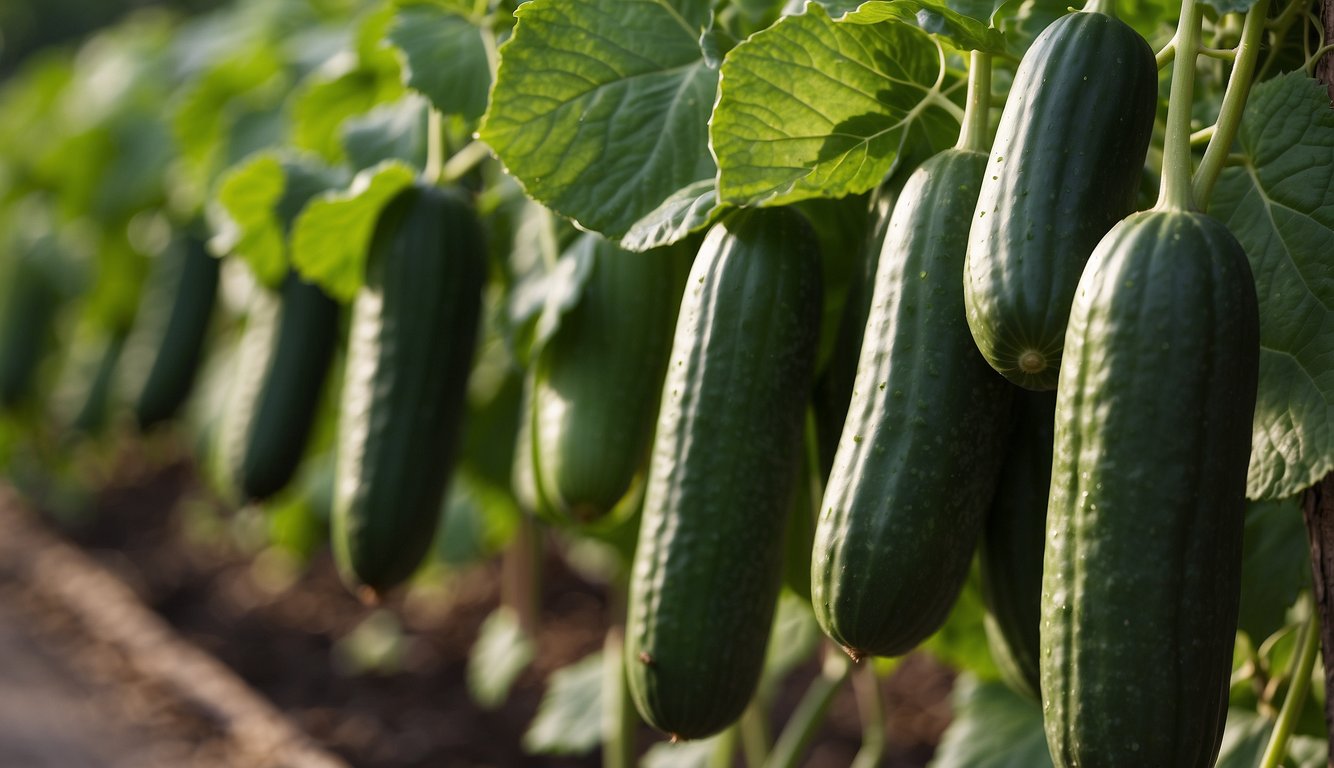Growing cucumbers in grow bags is a fantastic way to enjoy fresh cucumbers all summer. Even with limited space, you can succeed. Grow bags are ideal for balconies, patios, or even indoors. They are also excellent for avoiding the hassle of traditional gardening.
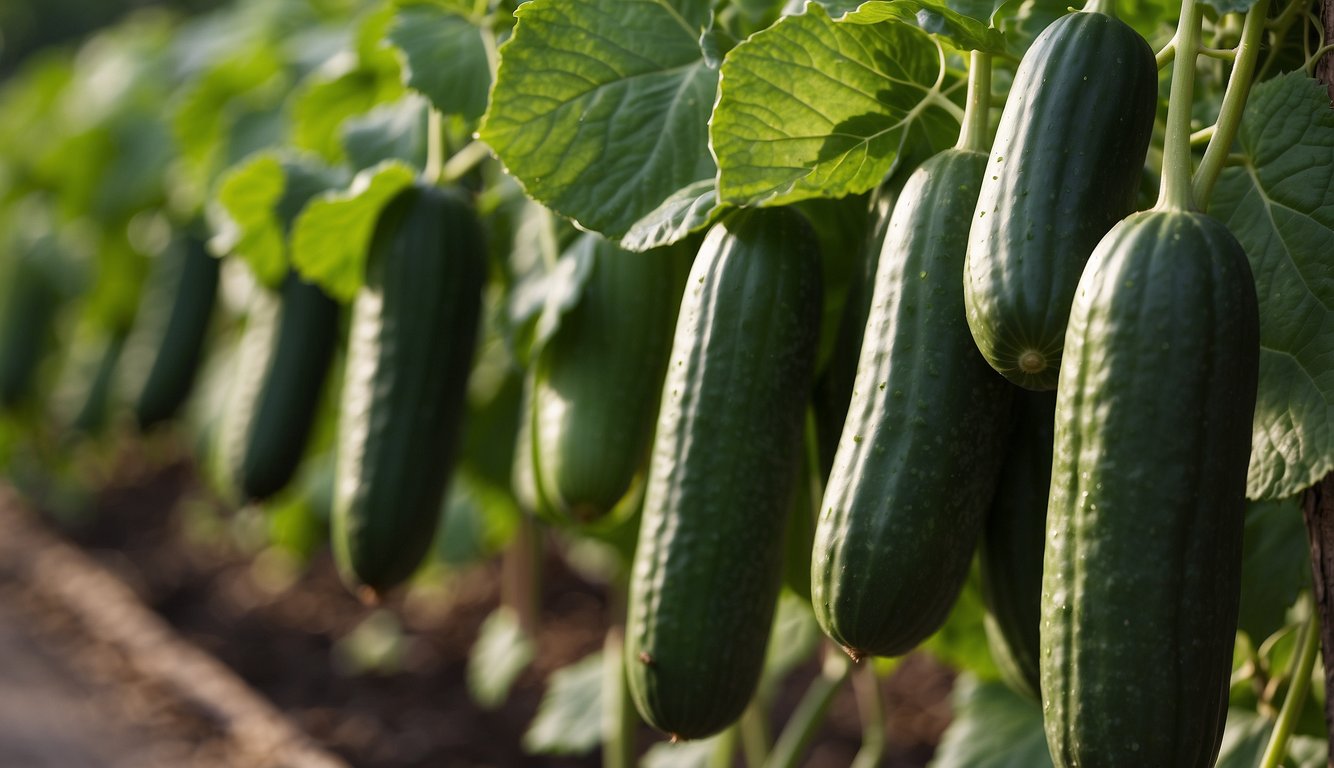
To begin, you will need to choose the right grow bag and soil mix. The size of the grow bag will depend on how many cucumbers you want to grow and the available space. It is recommended to use a 5-gallon grow bag for each cucumber plant. The soil mix should be well-draining with plenty of organic matter. You can purchase a pre-made soil mix or make your own by combining equal parts of peat moss, perlite, and vermiculite.
Once you have your grow bag and soil mix, it is time to plant your cucumber seeds. You can either start your seeds indoors and then transplant them outside, or you can sow them directly into the grow bag. Make sure to follow the instructions on the seed packet for planting depth and spacing. Cucumbers need plenty of sunlight, so make sure to place your grow bags in an area that receives at least six hours of direct sunlight per day.
Choosing the Right Grow Bags – Growing Cucumbers in Grow Bags
As someone who has grown cucumbers in grow bags before, I know that choosing the right grow bag is important for the success of your plants. In this section, I will discuss the two main factors to consider when choosing grow bags for your cucumber plants: material and breathability, as well as size and space considerations.
Material and Breathability – Growing Cucumbers in Grow Bags
When it comes to material, there are different options available for grow bags such as fabric, plastic, and even burlap. However, I recommend using fabric grow bags because they are breathable and allow for proper air circulation, which is important for healthy root development. Additionally, fabric grow bags are lightweight and easy to move around, especially if they come with handles.
Size and Space Considerations
The size of your grow bag is also important to consider. Generally, a 5-gallon grow bag is suitable for most cucumber plants. However, if you opt for a bush variety, a smaller grow bag may suffice. Keep in mind that cucumbers have extensive root systems, so a larger grow bag will provide more space for root development.
Another important factor to consider is space. Make sure you have enough space in your growing area for the number of grow bags you plan to use. Additionally, make sure the grow bags have proper drainage to prevent overwatering and root rot.
In summary, when choosing grow bags for your cucumber plants, I recommend using fabric grow bags for their breathability and lightweight design. Additionally, make sure to choose the appropriate size based on the type of cucumber plant you are growing and the amount of space you have. With the right grow bags, your cucumber plants are sure to thrive.
Understanding Soil and Potting Mix – Growing Cucumbers in Grow Bags
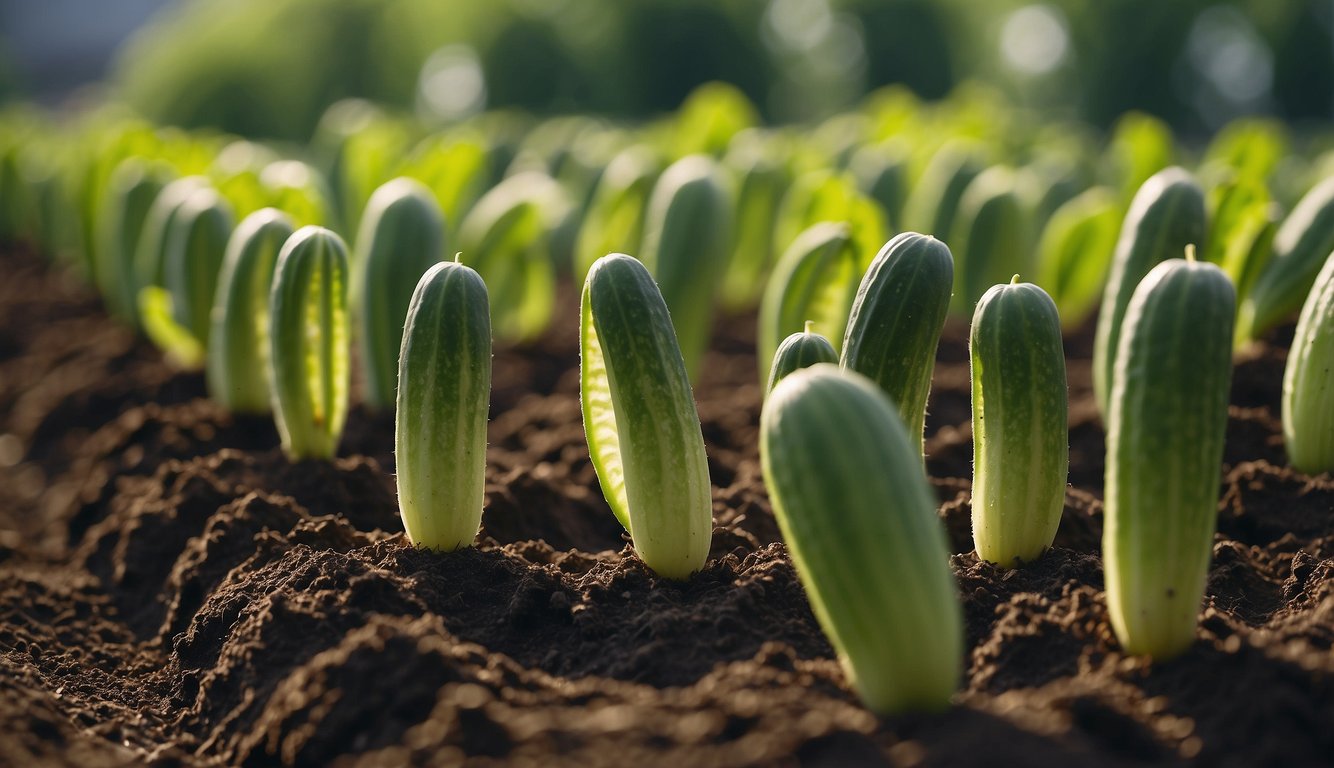
As a gardener, I know that the soil is the foundation of any successful garden. When it comes to growing cucumbers in grow bags, selecting the right potting mix is crucial. In this section, I will discuss the importance of selecting the right potting mix and ensuring good drainage.
Selecting the Potting Mix – Growing Cucumbers in Grow Bags
The potting mix is the growing medium that you will use to fill your grow bags. It is important to select a high-quality potting mix that is specifically formulated for container gardening. Look for a mix that contains a balanced blend of organic matter, compost, perlite, vermiculite, and peat moss. These ingredients will provide the necessary nutrients and ensure good drainage.
Organic matter is essential for healthy plant growth. It provides the necessary nutrients and helps to retain moisture in the soil. Compost is an excellent source of organic matter and will help to improve the nutrient content of the potting mix. Perlite and vermiculite are lightweight materials that improve drainage and aeration. Peat moss is another organic material that helps to retain moisture in the soil.
Ensuring Good Drainage
Good drainage is essential for healthy plant growth. When growing cucumbers in grow bags, it is important to ensure that the potting mix has good drainage. This will prevent water from accumulating in the bottom of the bag and causing root rot.
To ensure good drainage, choose a potting mix that contains perlite and vermiculite. These materials will improve the drainage and aeration of the soil. Additionally, make sure that the grow bag has drainage holes in the bottom. This will allow excess water to drain out of the bag and prevent water from accumulating in the bottom.
In summary, selecting the right potting mix and ensuring good drainage are essential for growing healthy cucumbers in grow bags. Look for a potting mix that contains a balanced blend of organic matter, compost, perlite, vermiculite, and peat moss. Make sure that the grow bag has drainage holes in the bottom and that the potting mix has good drainage. With the right potting mix and good drainage, you can grow healthy and delicious cucumbers in your grow bags.
Planting Cucumber Seeds – Growing Cucumbers in Grow Bags
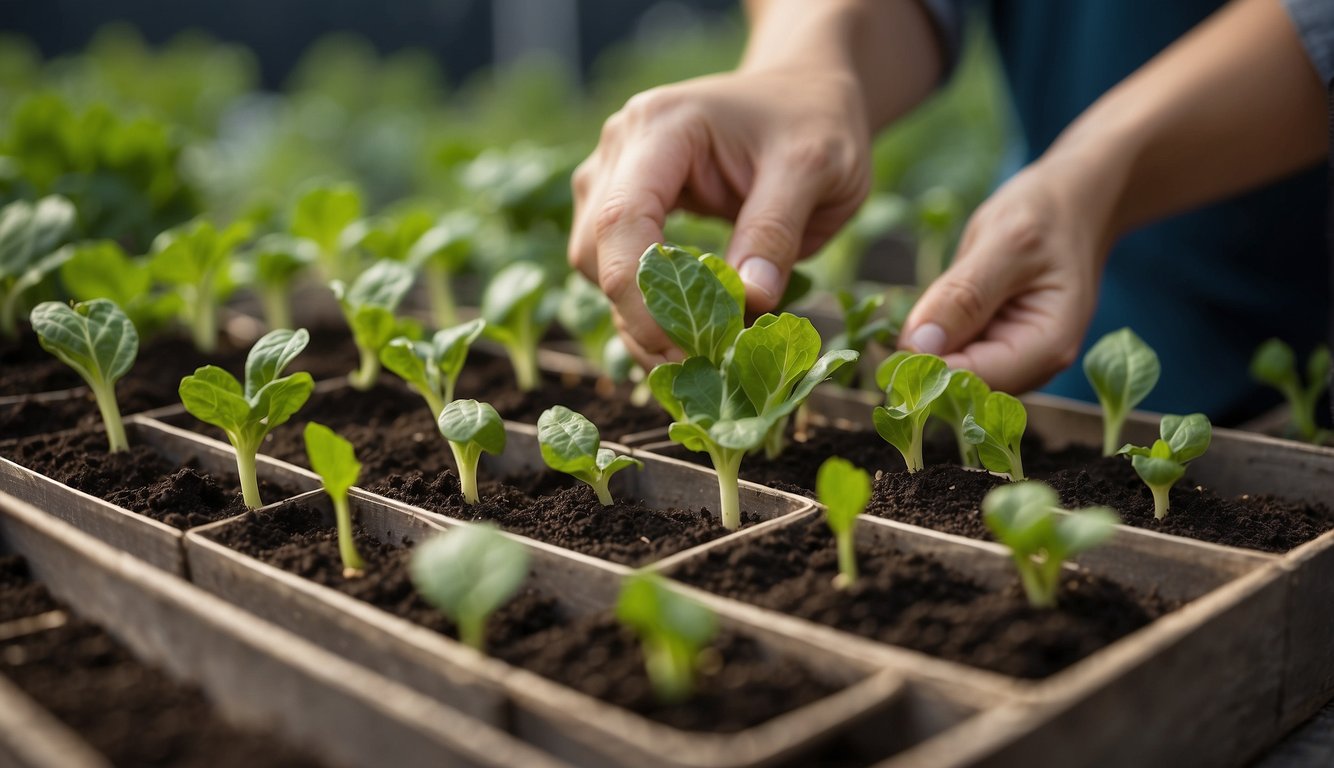
Growing cucumbers in grow bags is a great way to enjoy fresh cucumbers all season long. When planting cucumber seeds in grow bags, it is important to follow the right steps to ensure that your plants grow healthy and strong.
Germination Process
Before planting cucumber seeds in a grow bag, it is important to germinate the seeds. To do this, I soak the seeds in water for 24 hours. This helps to soften the seed coat and speed up the germination process.
Once the seeds have been soaked, I plant them in a seed-starting mix in small containers. I make sure to keep the soil moist but not waterlogged, and place the containers in a warm, sunny location. In about 7-10 days, the seeds should start to sprout.
Transplanting Seedlings – Growing Cucumbers in Grow Bags
After the seedlings have developed their true leaves, they are ready to be transplanted into the grow bags. I fill the grow bags with a good quality potting mix that contains organic material and has good drainage.
Then I make a small hole in the center of the potting mix and carefully transfer the seedling, making sure to cover the roots with soil. I then water the seedling and place the grow bag in a sunny location where it can get 6 to 8 hours of sunlight each day.
By following these steps, I have been able to successfully grow healthy cucumber plants in grow bags.
Watering and Moisture Management
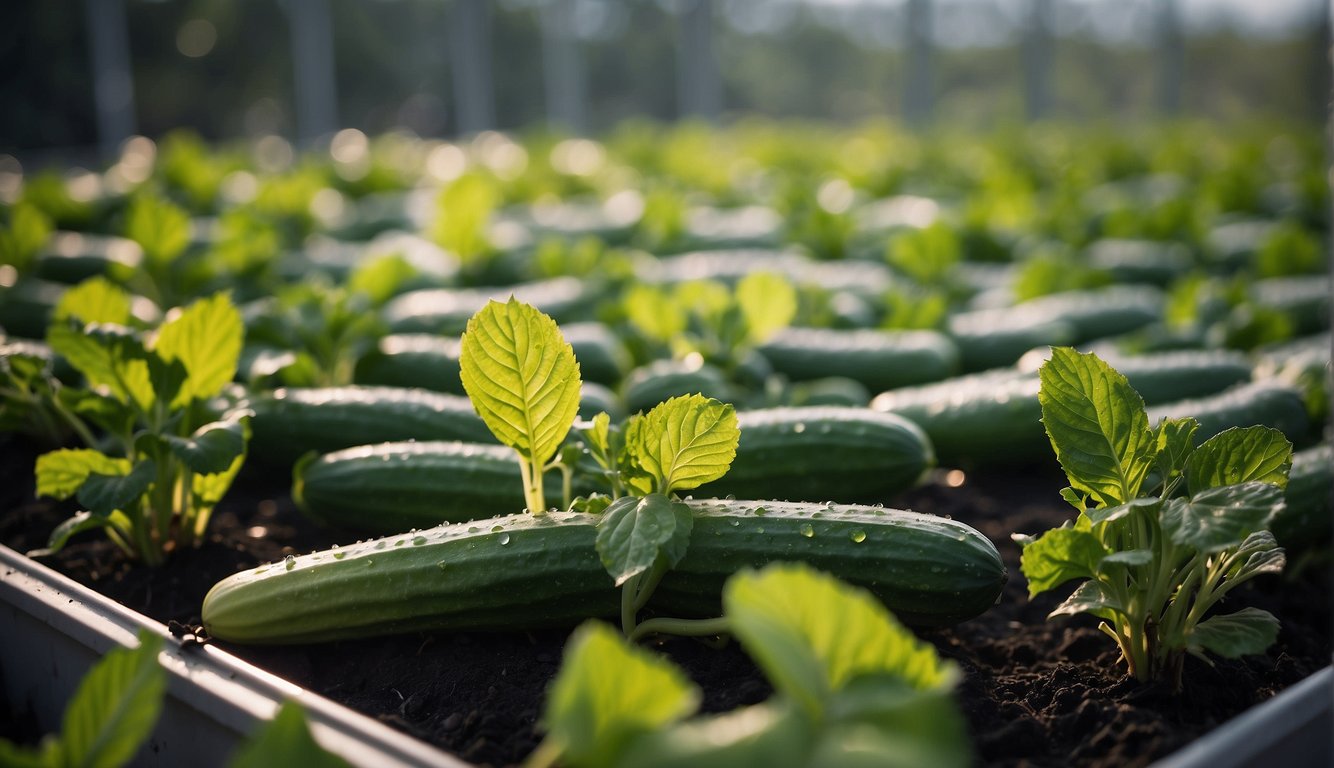
As a gardener, I know that watering and moisture management are crucial for the successful growth of cucumbers in grow bags. In this section, I will share my knowledge on the best practices for watering and moisture retention techniques.
Setting a Watering Schedule
The key to watering cucumbers in grow bags is to maintain consistent moisture levels. Overwatering or underwatering can lead to stunted growth and even death of the plant. I recommend setting a watering schedule based on the weather conditions and the size of the grow bag.
During hot and dry weather, cucumbers in grow bags may require watering once a day, while during cooler weather, they may only need watering once every two to three days. It is important to check the soil moisture level before watering. This can be done by sticking your finger into the soil up to the first knuckle. If the soil feels dry, it’s time to water.
Moisture Retention Techniques
In addition to setting a watering schedule, there are several moisture retention techniques that can help keep the soil in the grow bags moist. One effective technique is to use drip irrigation. This method delivers water directly to the roots of the plants, reducing water loss due to evaporation.
Another technique is to add a layer of mulch to the surface of the soil. This can be made from materials such as straw, leaves, or grass clippings. Mulch helps to retain moisture by reducing water loss through evaporation and slowing down the rate at which the soil dries out.
Finally, it’s important to choose a high-quality grow bag made of breathable material that allows air and water to flow freely through the container walls. This helps keep the soil inside the container well-aerated and ensures healthy growth.
By following these watering and moisture retention techniques, you can ensure that your cucumbers in grow bags receive the consistent moisture they need to thrive.
Nutrition and Fertilizing – Growing Cucumbers in Grow Bags
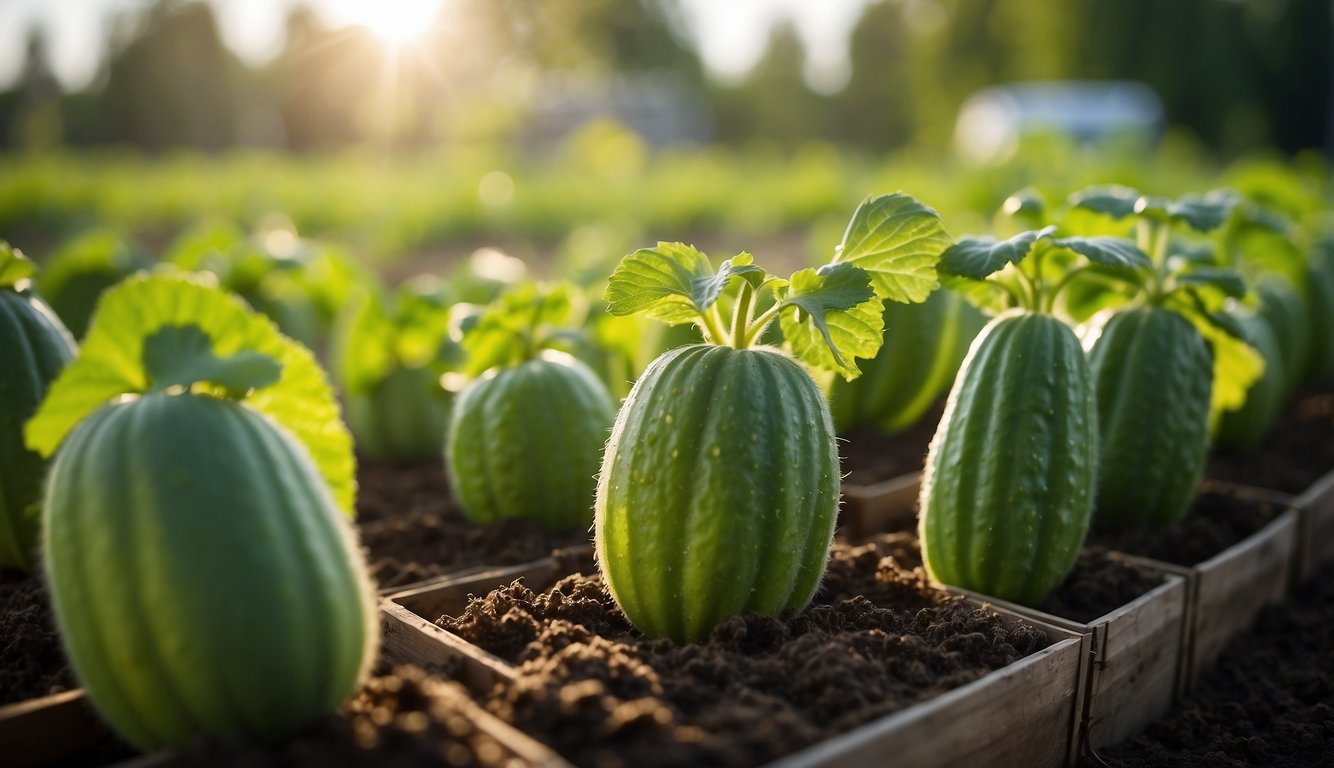
Cucumbers are heavy feeders, and they require a lot of nutrients to grow healthy and produce a bountiful harvest. Therefore, it’s essential to fertilize them regularly to ensure they have the necessary nutrients to grow. In this section, I will discuss the importance of nutrition and fertilizing for growing cucumbers in grow bags.
Choosing the Right Fertilizer
When it comes to fertilizing cucumbers, it’s essential to choose the right fertilizer. There are many different types of fertilizers available in the market, such as organic, inorganic, slow-release, and liquid fertilizers. Organic fertilizers are made from natural materials, such as compost, manure, and bone meal, and they are a great choice for growing cucumbers in grow bags. They release nutrients slowly and help improve soil structure and fertility.
Inorganic fertilizers, on the other hand, are made from synthetic materials, such as ammonium nitrate and potassium sulfate. They release nutrients quickly and are more potent than organic fertilizers. However, they can also damage soil structure and kill beneficial microorganisms.
Slow-release fertilizers are a great choice for growing cucumbers in grow bags. They release nutrients slowly over time and help improve soil structure and fertility. They also reduce the risk of over-fertilizing, which can lead to nutrient burn and plant damage.
Fertilizing Routine
To ensure your cucumbers have the necessary nutrients to grow healthy and produce a bountiful harvest, you need to develop a fertilizing routine. During the early stages of growth, cucumbers require a lot of nitrogen to grow healthy foliage. Therefore, it’s essential to fertilize them with a high-nitrogen fertilizer every two weeks until they start flowering.
Once the cucumbers start flowering, they require more phosphorus and potassium to produce healthy fruits. Therefore, it’s essential to switch to a high-phosphorus and high-potassium fertilizer during this stage. You should continue fertilizing them every two weeks until the end of the growing season.
Growing cucumbers in grow bags requires proper nutrition and fertilizing to ensure healthy growth and a bountiful harvest. By choosing the right fertilizer and developing a fertilizing routine, you can provide your cucumbers with the necessary nutrients to grow healthy and produce delicious fruits.
Supporting Cucumber Plants – Growing Cucumbers in Grow Bags

As cucumber plants grow, they need support to keep them off the ground and prevent damage to the fruit. There are different ways to support cucumber plants, depending on the variety and growing conditions. In this section, I will discuss two methods of supporting cucumber plants: using trellises and training vining varieties.
Using Trellises
Trellising is a common method of supporting cucumber plants. It involves setting up a structure that the plants can climb on as they grow. A trellis can be made of wood, bamboo, or metal. It should be sturdy enough to support the weight of the plants and the fruit. The trellis should be at least 6 feet tall to accommodate the height of the plants.
To set up a trellis, I start by driving two stakes into the ground at each end of the row of cucumber plants. Then, I attach a horizontal support beam to the top of the stakes. I use twine or wire to create vertical supports between the horizontal beam and the ground. I space the supports about 1 foot apart. As the cucumber plants grow, I tie them to the supports using soft twine or plant ties. This keeps the plants upright and prevents them from sagging or breaking.
Trellising has several benefits. It keeps the plants off the ground, which reduces the risk of disease and pests. It also makes it easier to harvest the fruit. Trellising can also improve air circulation around the plants, which can help prevent fungal diseases.
Training Vining Varieties – Growing Cucumbers in Grow Bags
Vining cucumber varieties are another type of cucumber that needs support. They have long, trailing vines that can grow up to 6 feet long. To support vining cucumber plants, I use a method called “training.” This involves guiding the vines along a trellis or other support structure.
To train vining cucumber plants, I start by setting up a trellis or other support structure. Then, I plant the cucumber seeds or seedlings at the base of the structure. As the plants grow, I gently guide the vines up the trellis using soft twine or plant ties. I make sure to space the vines about 1 foot apart to prevent crowding.
Training vining cucumber plants has several benefits. It keeps the plants off the ground, which reduces the risk of disease and pests. It also makes it easier to harvest the fruit. Training can also improve root development by encouraging the plants to grow vertically instead of horizontally.
Supporting cucumber plants is essential for healthy growth and a bountiful harvest. Trellising and training vining varieties are two effective methods of supporting cucumber plants. By following these methods, I can keep my cucumber plants healthy and productive throughout the growing season.
Managing Pests and Diseases – Growing Cucumbers in Grow Bags
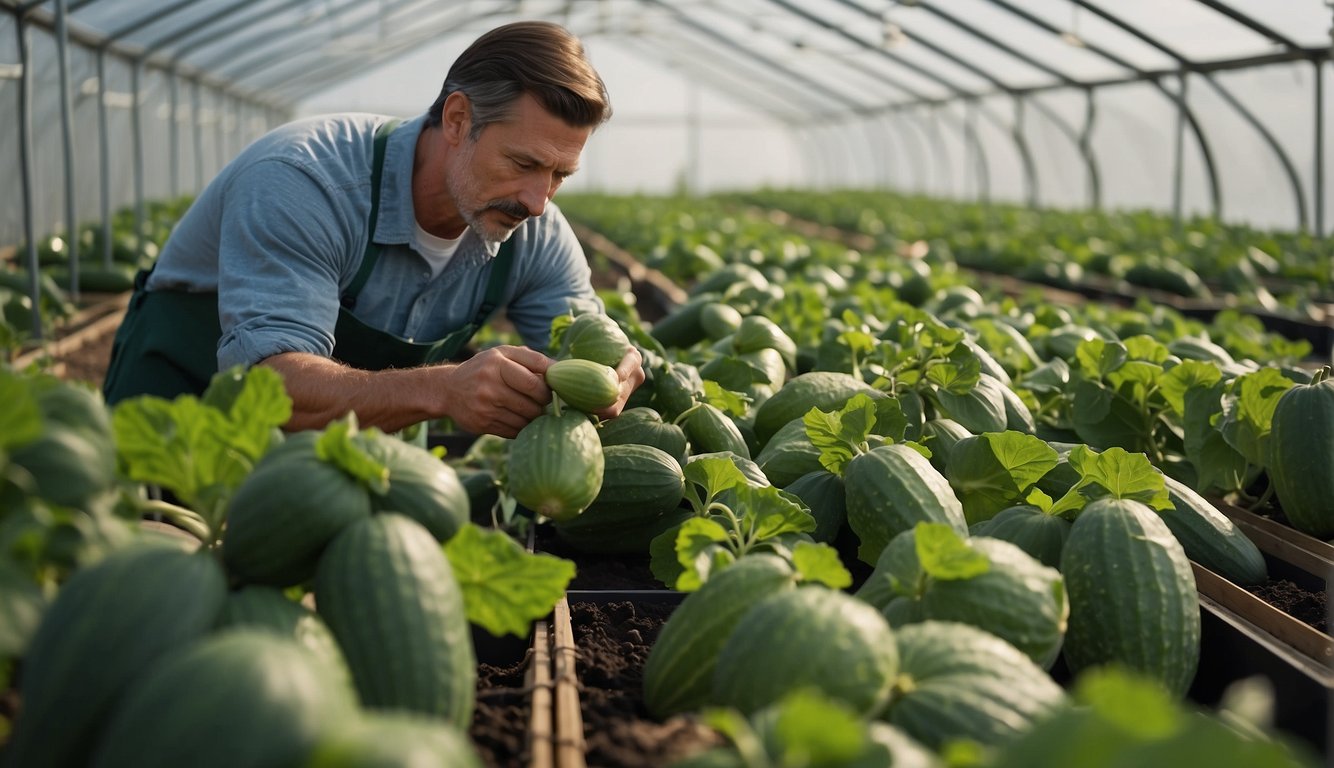
Growing cucumbers in grow bags can be a great way to maximize your garden space and enjoy a bountiful harvest. However, pests and diseases can be a real challenge for any gardener. In this section, I will cover some of the common pests and diseases that can affect cucumbers and provide tips on how to manage them.
Identifying Common Pests
Pests are a common problem when growing cucumbers in grow bags. Some of the most common pests that can affect cucumbers include aphids, spider mites, and cucumber beetles. Aphids are small, soft-bodied insects that can be found on the undersides of leaves. Spider mites are tiny pests that can cause damage to the leaves and fruits of cucumber plants. Cucumber beetles are small, striped insects that can cause damage to the leaves and fruits of cucumber plants.
Preventing Diseases
Diseases can also be a problem when growing cucumbers in grow bags. Two of the most common diseases that can affect cucumbers are powdery mildew and cucumber mosaic virus. Powdery mildew is a fungal disease that can cause a white, powdery coating to appear on the leaves of cucumber plants. Cucumber mosaic virus is a viral disease that can cause a mosaic pattern to appear on the leaves of cucumber plants.
One way to prevent diseases is to choose cucumber varieties that are disease-resistant. Disease-resistant varieties are available for both powdery mildew and cucumber mosaic virus. Another way to prevent diseases is to practice good sanitation. This includes removing any infected plant material and keeping the grow bags clean and free of debris.
Managing pests and diseases is an important part of growing cucumbers in grow bags. By identifying common pests and preventing diseases, you can help ensure a healthy and bountiful harvest.
Harvesting and Storage – Growing Cucumbers in Grow Bags

Determining Harvest Time
When it comes to harvesting cucumbers grown in grow bags, it’s important to know when to pick them. Generally, cucumbers are ready to harvest when they reach a length of 6-8 inches and have a bright green color. However, it’s important to check the variety of cucumber you are growing as some varieties may be ready to harvest at a smaller size.
One way to determine if your cucumber is ready to harvest is by gently squeezing it. If it feels firm and has a slight give, then it’s ready to be picked. If it feels soft or squishy, then it’s overripe and should be discarded.
It’s also important to harvest cucumbers regularly to encourage the plant to produce more fruit. Leaving overripe cucumbers on the vine can signal to the plant that it doesn’t need to produce any more fruit, resulting in a lower yield.
Storing Homegrown Cucumbers – Growing Cucumbers in Grow Bags
Once you’ve harvested your cucumbers, it’s important to store them properly to ensure they stay fresh. Homegrown cucumbers can be stored in the refrigerator for up to a week.
To store cucumbers, wrap them in a paper towel and place them in a plastic bag or container with a lid. This will help absorb any excess moisture and prevent the cucumbers from becoming slimy.
It’s also important to store cucumbers away from other fruits and vegetables that produce ethylene gas, such as apples and bananas. Ethylene gas can cause cucumbers to ripen and spoil more quickly.
By following these simple tips, you can enjoy a bountiful harvest of homegrown cucumbers and store them properly to enjoy them for longer.
Troubleshooting Common Issues

As with any type of gardening, there are common issues that may arise when growing cucumbers in grow bags. Here are some of the most common problems and how to address them.
Dealing with Overwatering – Growing Cucumbers in Grow Bags
Overwatering is a common problem when growing cucumbers in grow bags. It can lead to root rot and other issues that can harm the plant. To avoid overwatering, make sure that the soil is well-draining and that the grow bag has adequate drainage holes.
If you suspect that your cucumbers are suffering from overwatering, stop watering the plant immediately and allow the soil to dry out. You may also want to consider repotting the plant in fresh soil to help prevent further damage.
Addressing Insufficient Sunlight
Cucumbers need plenty of sunlight to grow and thrive. If your grow bag is not getting enough sunlight, your cucumbers may suffer from stunted growth or may not produce fruit at all.
To address this issue, try moving your grow bag to a sunnier location. If that’s not possible, consider using a grow light to provide additional light to your plants. You may also want to prune any nearby trees or bushes that may be blocking sunlight from reaching your grow bag.
Remember, cucumbers need at least 6-8 hours of direct sunlight each day to grow and produce fruit. Keep an eye on the temperature as well, as cucumbers prefer warm temperatures and may not grow well in cooler climates.
The Crunchy Connection: Growing Cucumbers in Grow Bags and The Herb Prof
Let’s crunch into the topic of growing cucumbers in grow bags and its connection to our herbal paradise, theherbprof.com. Ready for a crunchy adventure?
Firstly, growing cucumbers in grow bags is a practice of innovation and flexibility. It’s about adapting gardening techniques for space efficiency. Sounds familiar? That’s because theherbprof.com helps you adapt to the ever-changing world of herbs!
Secondly, both cucumber cultivation and theherbprof.com are about sustainable growth. Just like grow bags provide a sustainable solution for urban gardening, theherbprof.com promotes sustainable practices in herb cultivation.
Lastly, they both aim to enrich our lives. Cucumbers add a crunch to our salads, while theherbprof.com adds a crunch to our minds with herbal wisdom. You can check our homepage here!
So, there you have it! Growing cucumbers in grow bags and theherbprof.com are a crunchy pair indeed. They both symbolize innovation, sustainable growth, and enrichment. Now, isn’t that a crunchy piece of information to share at your next garden party? Keep growing, folks!
References – Growing Cucumbers in Grow Bags
Little Herb Encyclopedia, by Jack Ritchason; N.D., Woodland Publishing Incorporated, 1995
The Ultimate Healing System, Course Manual, Copyright 1985, Don Lepore
Planetary Herbology, Michael Tierra, C.A., N.D., Lotus Press, 1988
Handbook of Medicinal Herbs, by James A. Duke, Pub. CRP Second Edition 2007
The Complete Medicinal Herbal, by Penelope Ody, Published by Dorling Kindersley
Check the Following Articles!
Hydroponic Basil from Grocery Store: How to Grow at Home
Tomato Leaves Turning White: Causes and Solutions
Growing Peppers in a Greenhouse: Tips and Techniques
Frequently Asked Questions – Growing Cucumbers in Grow Bags
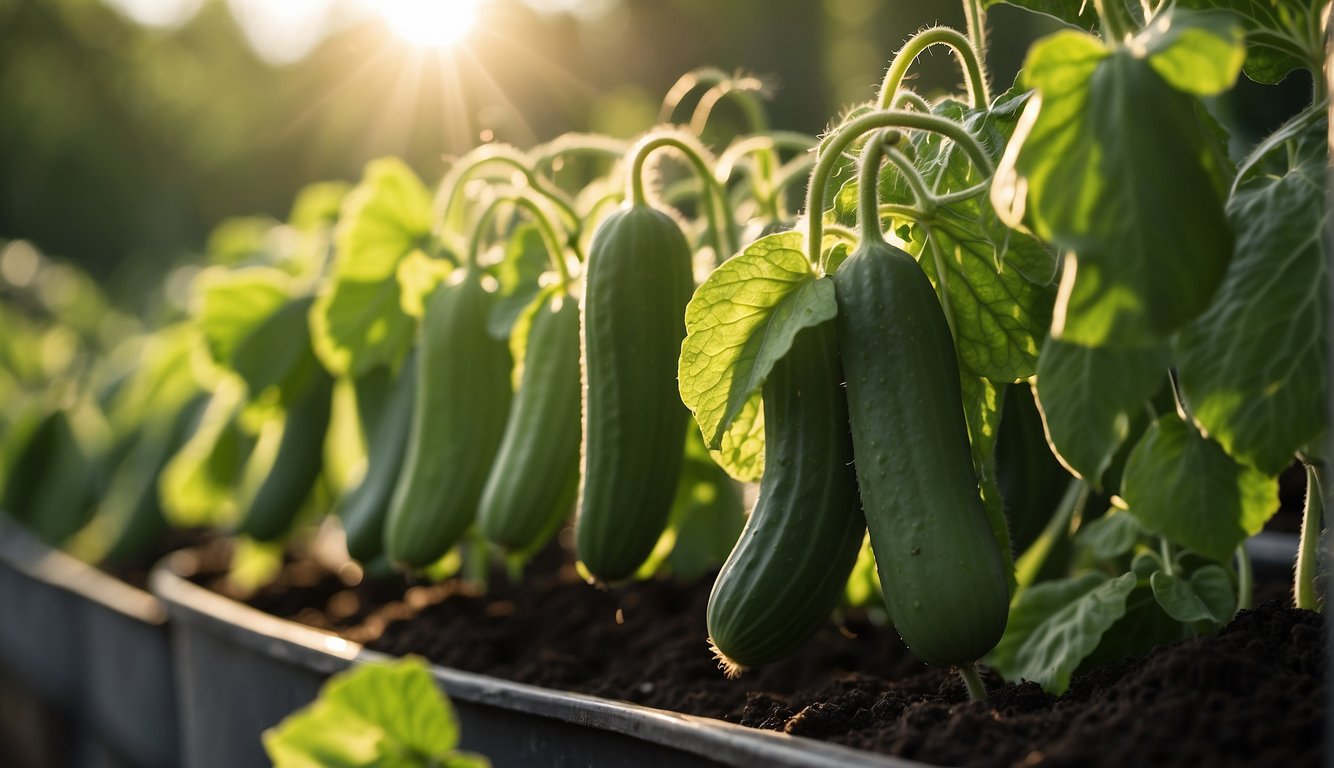
What are the best cucumber varieties for growing in small spaces or containers?
When it comes to growing cucumbers in small spaces or containers, it is important to choose a variety that is well-suited for this type of gardening. Some of the best cucumber varieties for container gardening include Bush Champion, Salad Bush, and Spacemaster. These varieties are compact and produce high yields of delicious cucumbers.
How do you set up a trellis for supporting cucumbers in grow bags?
Setting up a trellis for supporting cucumbers in grow bags is a great way to maximize space and ensure healthy growth. To set up a trellis, you will need to insert a sturdy stake or pole into the center of the grow bag. Then, attach a trellis netting or mesh to the stake or pole and secure it in place. As your cucumber plants grow, gently train them to climb up the trellis for support.
Which plants make the best companions for cucumbers in container gardening?
Companion planting is a great way to maximize space and promote healthy growth in container gardening. Some of the best companion plants for cucumbers include beans, peas, radishes, and lettuce. These plants help to improve soil health, provide shade and support, and reduce the risk of pests and diseases.
How many cucumber plants can be successfully grown in a 5-gallon grow bag?
When it comes to growing cucumbers in a 5-gallon grow bag, it is best to limit the number of plants to one or two. This will ensure that each plant has enough space and nutrients to grow and produce healthy cucumbers.
Is it necessary to create drainage holes in grow bags for cucumber plants?
Yes, it is essential to create drainage holes in grow bags for cucumber plants. These holes allow excess water to drain out of the grow bag and prevent waterlogged soil, which can lead to root rot and other problems. Make sure to create several drainage holes in the bottom of the grow bag and check regularly to ensure proper drainage.
What are some effective tips for maximizing cucumber yield in container gardening?
To maximize your cucumber yield in container gardening, it is important to provide your plants with plenty of sunlight, water, and nutrients. Choose a well-draining potting mix and fertilize regularly with a balanced fertilizer. Additionally, make sure to harvest your cucumbers regularly to promote continued growth and production.
